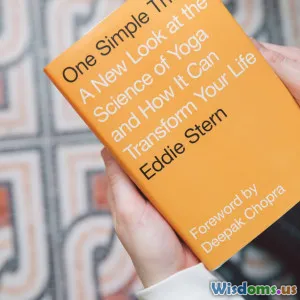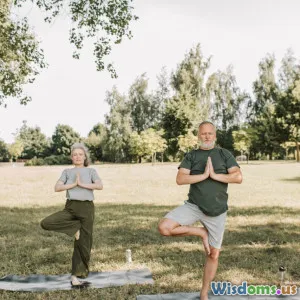
Is Hot Yoga or Traditional Yoga Better for Inner Peace and Growth
8 min read Explore whether hot yoga or traditional yoga better fosters inner peace and personal growth in this detailed, insightful comparison. (0 Reviews)
Is Hot Yoga or Traditional Yoga Better for Inner Peace and Growth?
Yoga has evolved into a global phenomenon, drawing millions seeking not only physical fitness but inner peace and personal growth. Among the diverse styles, hot yoga and traditional yoga stand out for their unique approaches and touted benefits. But when it comes to fostering deep inner peace and meaningful growth, which truly reigns supreme?
This comprehensive exploration dissects the philosophies, practices, and outcomes of both to help you understand which path aligns best with your quest for tranquility and self-development.
Understanding the Foundations: What Are Hot Yoga and Traditional Yoga?
Traditional Yoga: A Timeless Holistic Practice
Traditional yoga—rooted in ancient Indian philosophy—encompasses a vast spectrum of practices including asanas (postures), pranayama (breath control), dhyana (meditation), and ethical living (Yamas and Niyamas). Its primary goal transcends physical fitness, targeting the union of mind, body, and spirit.
Different branches like Hatha, Iyengar, and Kundalini emphasize precise alignment, breath awareness, or energetic awakening to nurture mental calmness and insight.
Hot Yoga: Modern Adaptation with a Fiery Twist
Hot yoga, popularized by figures like Bikram Choudhury, is typically practiced in a heated room averaging 95–105°F (35–40°C) with high humidity. This environment intensifies physical exertion through a fixed sequence of 26 postures paired with two breathing exercises.
The heat purportedly increases flexibility, detoxification via sweating, and cardiovascular benefits, appealing to those looking for vigorous exercise combined with yogic discipline.
Physical and Mental Benefits: Comparing Impact on Inner Peace
Traditional Yoga: Cultivating Mindfulness and Presence
Traditional yoga’s measured pace encourages mindfulness—focusing on breath and bodily sensations fosters a meditative state even during movement. Studies support its efficacy:
- A 2018 meta-analysis published in Mindfulness Journal showed traditional yoga reduces anxiety and improves emotional regulation.
- Practitioners often report clearer mental states, reduced stress levels, and a rooted sense of calm.
For example, Iyengar yoga’s emphasis on alignment and props allows even beginners a patient, deliberate approach, which can deepen awareness and acceptance—pillars of inner peace.
Hot Yoga: Stimulating Endorphins and Resilience
The intense heat amplifies cardiovascular demands and sweat, often triggering a euphoric 'runner's high' through endorphin release. Some benefits tied to hot yoga include:
- Enhanced stamina and muscle tone.
- Improved ability to endure discomfort, potentially translating psychologically into greater resilience.
However, the fast pace and high temperatures can overwhelm beginners, sometimes heightening anxiety rather than soothing it. Moreover, the physical focus might overshadow the meditative elements.
Practitioners like actress Emma Stone have cited hot yoga as a powerful detox and stress relief tool, but emphasize complementary traditional methods for deeper calm.
Spiritual Growth: Beyond the Mat and the Heat
The Depth of Traditional Yoga Philosophy
Traditional yoga integrates philosophical teachings from texts like the Yoga Sutras of Patanjali, which outline the eight limbs of yoga including ethical conduct, concentration, and meditation. This multilayered framework supports sustained inner growth through:
- Self-study (Svadhyaya): Encouraging introspection.
- Detachment (Vairagya): Letting go of distractions.
Practicing traditional yoga often includes crafting a life aligned with these principles, fostering ongoing transformation rather than just momentary relief.
Hot Yoga and Its Limitations on Spiritual Dimensions
While hot yoga shares asanas and some breath control, its origin is mostly physical. The spiritual teachings and philosophies tend to be downplayed or absent.
Many studios fuse meditation pre- or post-class, but the core method emphasizes physical rigor. For dedicated seekers of spiritual wisdom and growth, exclusive reliance on hot yoga might feel insufficient.
Real-World Insights and Testimonials
Practitioner Stories
-
Jessica, 32, traditional yoga teacher: “With traditional yoga, I learned to breathe through pain and find stillness—not just on the cushion but in daily life. It’s transformed my reactions and relationships.”
-
Mark, 40, hot yoga enthusiast: “Hot yoga challenged me physically like nothing else. I feel stronger and more mentally tough. But balancing with meditation and slow yoga helps me harness peace deeper.”
Expert Opinions
Dr. Sat Bir Khalsa, a yoga researcher, states in a 2015 interview: "Traditional Yoga’s strength lies in melding body and mind with philosophy. Hot yoga offers physical benefits but benefits for mental clarity and peace are variable."
Considerations: Which Should You Choose?
Suitability for Your Goals and Temperament
-
If your primary goal is inner peace and long-term spiritual growth, traditional yoga’s holistic and steady approach likely offers the richest soil.
-
If you crave physical challenge alongside stress relief, with some mental benefits, hot yoga may energize and detoxify effectively.
Health Factors
Hot yoga isn’t recommended for those with cardiovascular issues, heat sensitivity, or pregnant women, whereas traditional yoga can usually be adapted safely for all levels.
Conclusion: A Unified Perspective
Neither hot yoga nor traditional yoga can be universally declared better for inner peace and growth. The answers rest in your individual journey, health, and aspirations.
Traditional yoga shines as a comprehensive discipline nurturing body, mind, and spirit in harmony, backed by centuries of wisdom and contemporary science.
Hot yoga offers compelling physical benefits and can catalyze mental resilience but typically lacks the depth of spiritual philosophy inherent in traditional styles.
For many, the optimal path merges both: using the invigorating heat to break resistance and a traditional mindful practice for genuine inner tranquility and growth.
As the influential yogi T.K.V. Desikachar summarized, “Yoga is not about touching your toes but what you learn on the way down.” Choose the approach that teaches you most about yourself.
Takeaway: Embrace yoga not just as exercise but as a lifetime journey of self-discovery. Whether you sweat it out in the heat or breathe gently in serene silence, the key to inner peace lies in consistent, heartfelt practice.
Rate the Post
User Reviews
Popular Posts




















